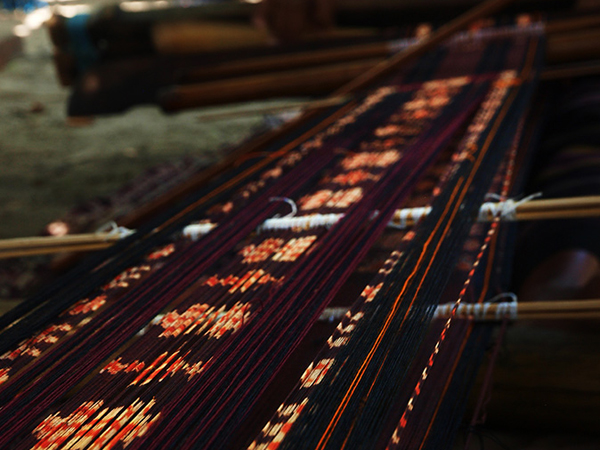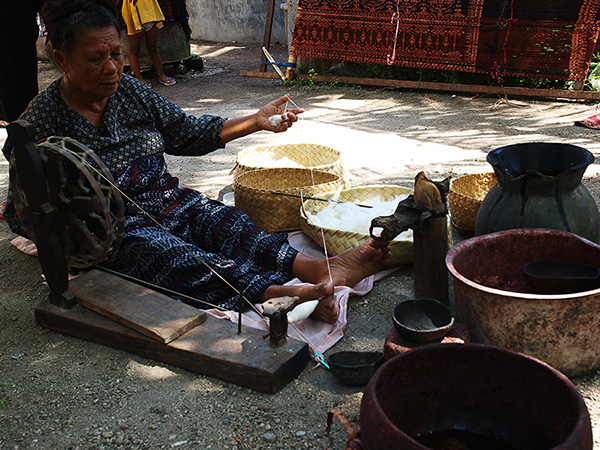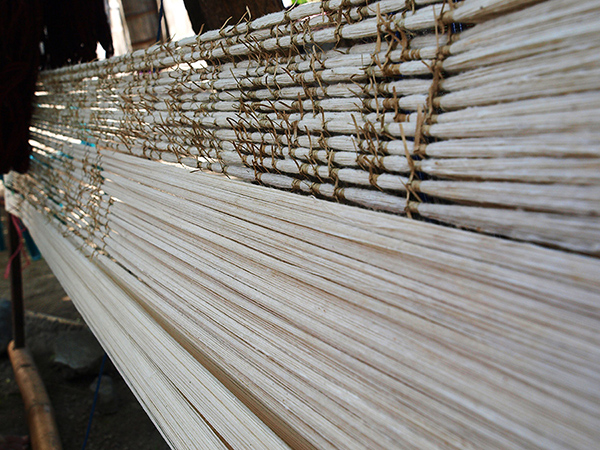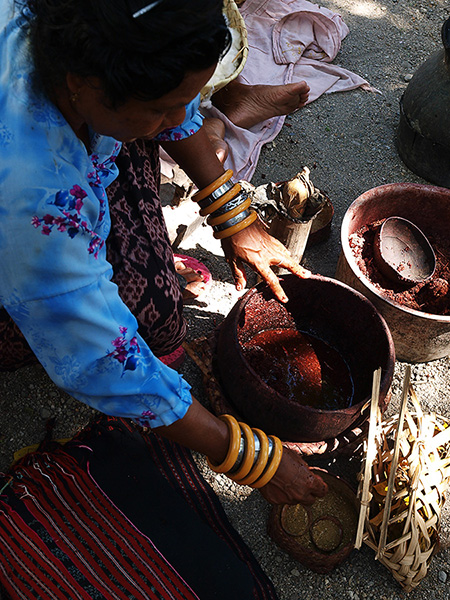In addition to its natural beauty, Flores also attracts people to visit with its cultural variety & diversity. And Ikat, a hand-woven fabric, is one of the icons of Flores cultural treasure. This traditional work of art can be found in several regions in this island that become the production center of the fabrics that require persistence and patience in the production process. Maumere, Sikka, Ende, Ngada, Lio, Larantuka and Lembata to name some of them. Each region has its distinct character, respectively, of the motifs, patterns and colors of the ikat fabrics produced. A reflection of the ethnic diversity, customs and daily lifes of Flores island.
During our Flores trip, we got the chance to visit the village of Sikka, one of the regions infamously known for its beautiful ikat fabrics production. Located on the southern coast of the Flores island, about 30km south-west of the town of Maumere, the village which has the same name with its district – Sikka is also the name of the district where this village is located – is not difficult to reach by vehicle, although the condition of the access road connecting the Maumere-Moni main road to this village is not quite good – some parts are quite badly damaged – forcing our minivan to move slowly to avoid the damaged parts of the small road..
The dusty village road welcomed us when we arrived at the village. There wasn’t much activity outside the houses, the village looked quiet. The beautiful portuguese-architecture old church in this village, which was built in 1899, seemed deserted. Maybe because it was not the day or time where people going for worship in the church. It was just quiet. However, according to Pak Paulus, our driver and guide, the quiet-look like this is a common thing. Other than the men who sail for fishing or work at the fields, most of the villagers stay in their houses, and they will only go out if there are guests visiting the village.
Our car stopped in front of one of the houses. At the yard, an old lady was busy working on a piece of ikat fabric. Pak Paulus was right, not long after we stepped out of the car the surrounding neighbors went out of their houses, greeting us, as well as carrying ikat fabrics and many other products made from ikat fabrics to offer. A wide variety of design, colors, styles and sizes, held in the courtyard. Meanwhile, the hostess and her family members were busy explaining and demonstrating the whole process of ikat weaving, which began with the cotton spinning..
The cotton yarn is obtained from the spinning process using a set of traditional tools, before it’s unfolded between two sticks. Then the next process to determine the motif and pattern of the ikat begins by knotting the yarn, forming the knots to the shape of the motif of the fabric-to-be. The part without knots is exposed and colored when the dyeing process is performed. At every coloring process, the to-be-colored part will be exposed and vice versa. To get the required colors, ikat fabric makers use natural ingredients. The red color is obtained from the roots of Kecubung (Noni). The blue color is made from the leaves of Indigo plant. Turmeric is used for yellow color. And many more. The coloring process itself takes long time, even months, depending on how complex the motifs and patterns are, because the yarn needs to dry before the next dyeing process to begin. After the entire coloring process is completed, then the yarn will be woven into a piece of cloth using a traditional loom.
Now, the shopping begans.. 😀
The price of ikat fabric varies, depending on the size of the cloth, the complexity of the patterns and motifs, as well as the purpose of the cloth with such motifs & patterns. For a piece of cloth with a particular motif used in traditional ceremonies, the price could reach millions rupiah. Not a cheap one, for sure. However, the production process itself is not easy. Further more, the beauty of these hand-made fabrics worth the high value.
Finally, after some hard bargaining process, few pieces of beautiful ikat fabrics changed hands..
Few other cars full of foreign tourists arrived at Sikka village, the home yard that had been turned into ikat exhibition, demonstration and sale scene was becoming increasingly crowded with the new arrivals. We were fortunate to arrive early, so we had a chance to chat with the host, been able to choose and get the fabrics we wanted at the price that was not too expensive. The seller happy, we were happy. A win-win situation.. 🙂
Just after mid-day, the cultural-visit-turned-to-shopping-session was over. Slowly, Pak Paulus drove the car that we were riding out of the village of Sikka, the journey resumed. Flores still save a lot of beauty that we wanted to visit within the rest of this narrow vacation time..
Photos from Flores trip are stored at:
- http://www.ismawanismail.com/gallery/index.php?/category/maumere
- http://www.ismawanismail.com/gallery/index.php?/category/kelimutu





Penjelasannya komprehensif banget 🙂
Hehehe, makasih.. apa kabar Banggai, encik Eva? Btw, gue baru berangan2 ke Togean situ dah nyampe aja.. 😀
Wah aku yg dari aceh kepengen ke flores setelah baca blog bapak. Semoga ada kesempatan kesana.
Salam kenal 🙂
Salam kenal juga Bang.. 🙂
Jangan lupa untuk keliling Indonesia, Indonesia itu indah. Saya juga ingin main-main lagi ke Aceh. Masih banyak tempat indah di kampong yang belum saya kunjungi.. 🙂